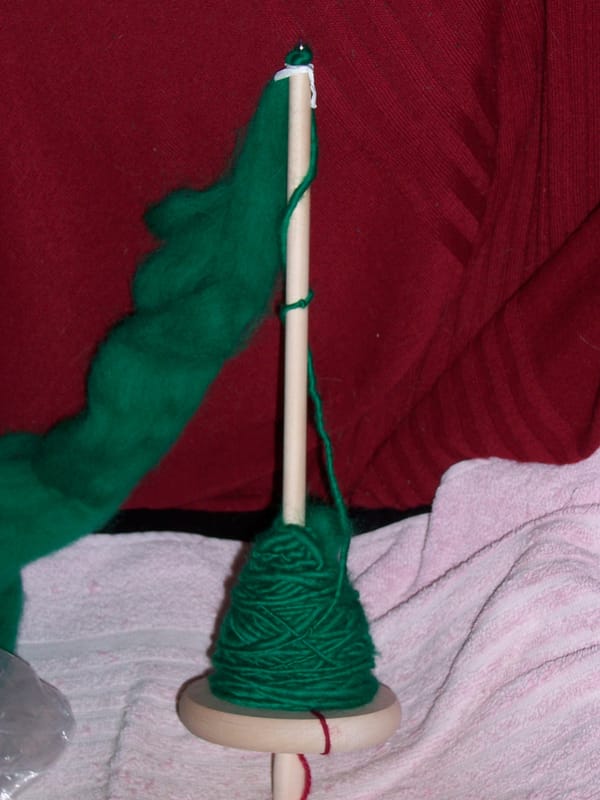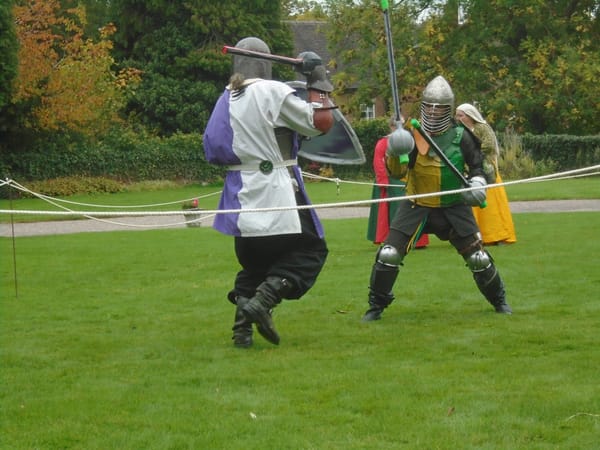The joy of socks (part 1)
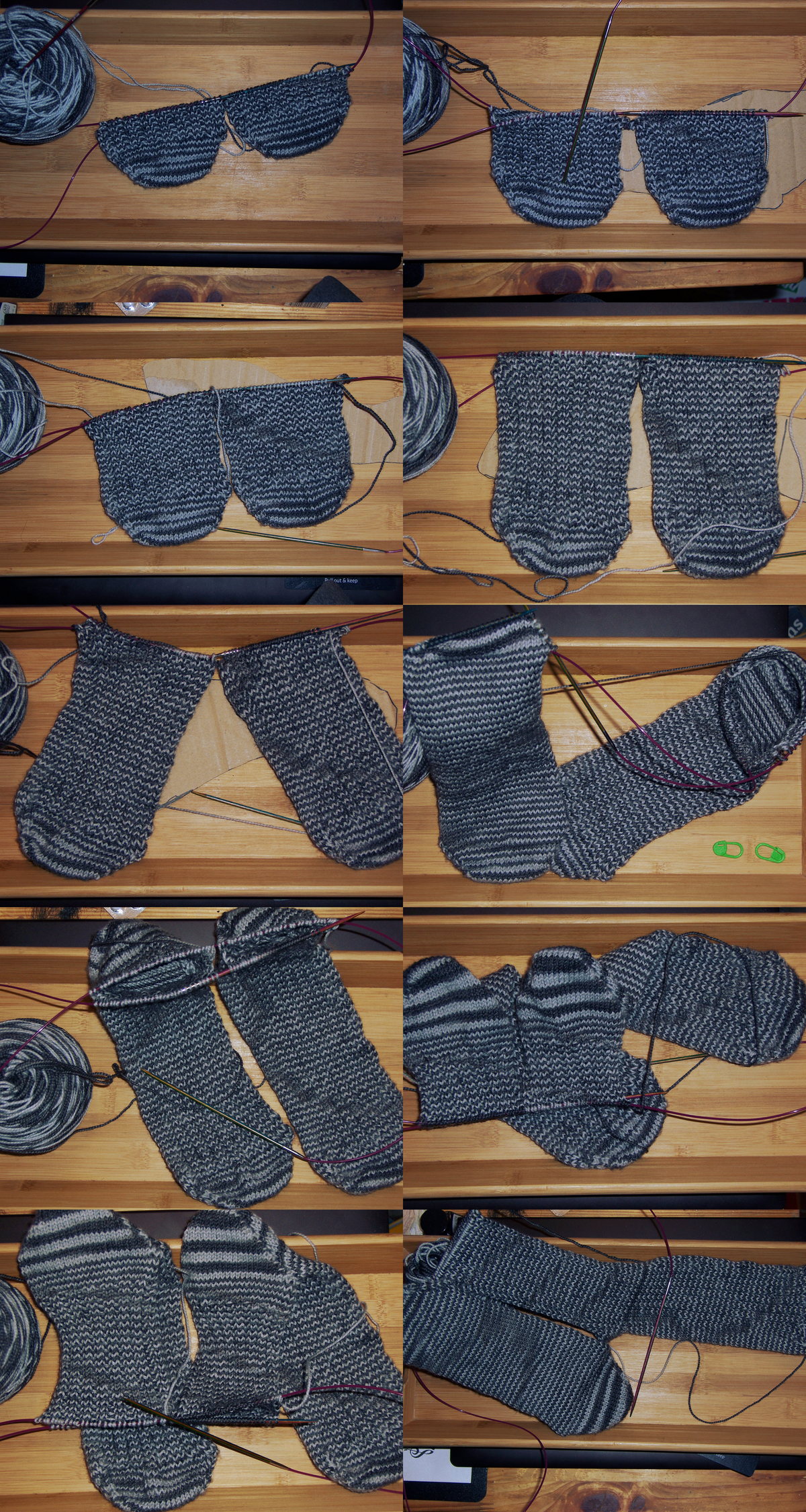
There are very many ways to knit socks, and everyone has their own preferred method. I'm going to talk about mine; it may not be yours. Sadly I do not still own the pair of socks in the feature photo, and the only one I have of them on my feet is part of a PDF, so you don't get to see just how well they fitted. But that's fine. I am going to be knitting some more socks that fit equally well.
There are two specific techniques I use for socks which I consider essential. The first one is Judy's Magic Cast-on. (It's easy enough to find YouTube tutorials if you prefer them, but, as usual, you get text from me. I personally have a PDF of the technique for reference, but I'm not sure where I found it, as it was quite a few years ago now.) This gives you the neatest possible finish at the toes; there is no seam or other extra bulk anywhere on either the inside or the outside, there aren't any holes, and it's also very easy to do, just as a bonus. Whatever you do about the heels, I would absolutely recommend this method for any kind of toe-up socks. It's also useful for anything similar, such as knitted bags or purses.
And the second technique is the rather oddly named Fish Lips Kiss Heel. (This isn't free. You do have to pay for the e-book tutorial. Having said that, it's only $2.49, and if you can't afford even that, you can get it for a dollar. She used to charge a dollar flat, but obviously there's been inflation since I bought it.) This is, again, very simple, but the results are impressive, as you can see from the photos in the link. You do not get the usual ladder of little holes; it is a wonderfully smooth and robust finish. The stitches just melt into one another. Not only that, but there's no counting involved because you can see exactly where you need to do your turn, every time. It was my sister - who's the major sock-knitter in our family - who put me onto both techniques, and ever since I found out about them I haven't knitted a pair of socks without them. (She also got me into KnitPro Symfonie needles, for that matter. I'd been using metal ones prior to that, and I will never go back to them; the Symfonies are made from specially treated wood, and they are far nicer to handle.)
I also do both socks at once. It looks as if it shouldn't be possible, but my sister has knitted any number of pairs this way and I've done a few myself, so it absolutely is. If you can find both ends of the ball, you can knit a pair of socks off a single ball; otherwise you need two, and I must admit I prefer using two, just in case there's a tangle in the middle. It means it's very easy to get them both the same length, and you avoid what my sister calls "second sock syndrome". That's very much a matter of individual preference, though.
Anyway, back to the Fish Lips Kiss Heel; the tutorial doesn't just cover how to do the heel itself (in fact, only two pages of it do that). It is a mine of useful information about how to fit and knit the perfect pair of socks. Fitting, in particular, can be a difficult one, because commercially made socks generally have a lot more stretch than hand-knitted ones, so you don't have so much margin for error. Marks & Spencer can make socks that will fit shoe sizes 4-7, but you probably can't unless you use elasticated yarn. So what you do is you make a cardboard template for your foot. Stand on a piece of card and get a friend to draw round it (no, you can't do this yourself and expect to get accurate results - believe me, I've tried!), and then get them to mark the exact location of the ankle bone. This is where you're going to turn your heel. The friend I normally have lunch with on Tuesdays has had to put off till Thursday this week, so I am taking some card and a marker up there and getting her to draw round my foot tomorrow. (She's used to me. She's the wife of the bloke to whom I once answered the door while holding a pair of wobble eyes on a stick.)
As previously mentioned, I have found some suitable winter-weight vegan sock yarn, which fills me with great delight. I can thoroughly recommend this site; Adelle will do custom dye jobs and doesn't charge any extra for them, and she is extremely helpful. Unfortunately she did forget to send my order wound into cakes - it was nearly Christmas at the time, she was tired and overworked, and these things happen - so I got skeins, rather to my chagrin; I don't knowingly buy skeins as they are such a hassle to rewind. (In fact, the first one got so tangled that it took me three hours to wind it into a ball! Fortunately the rest was a lot quicker.)
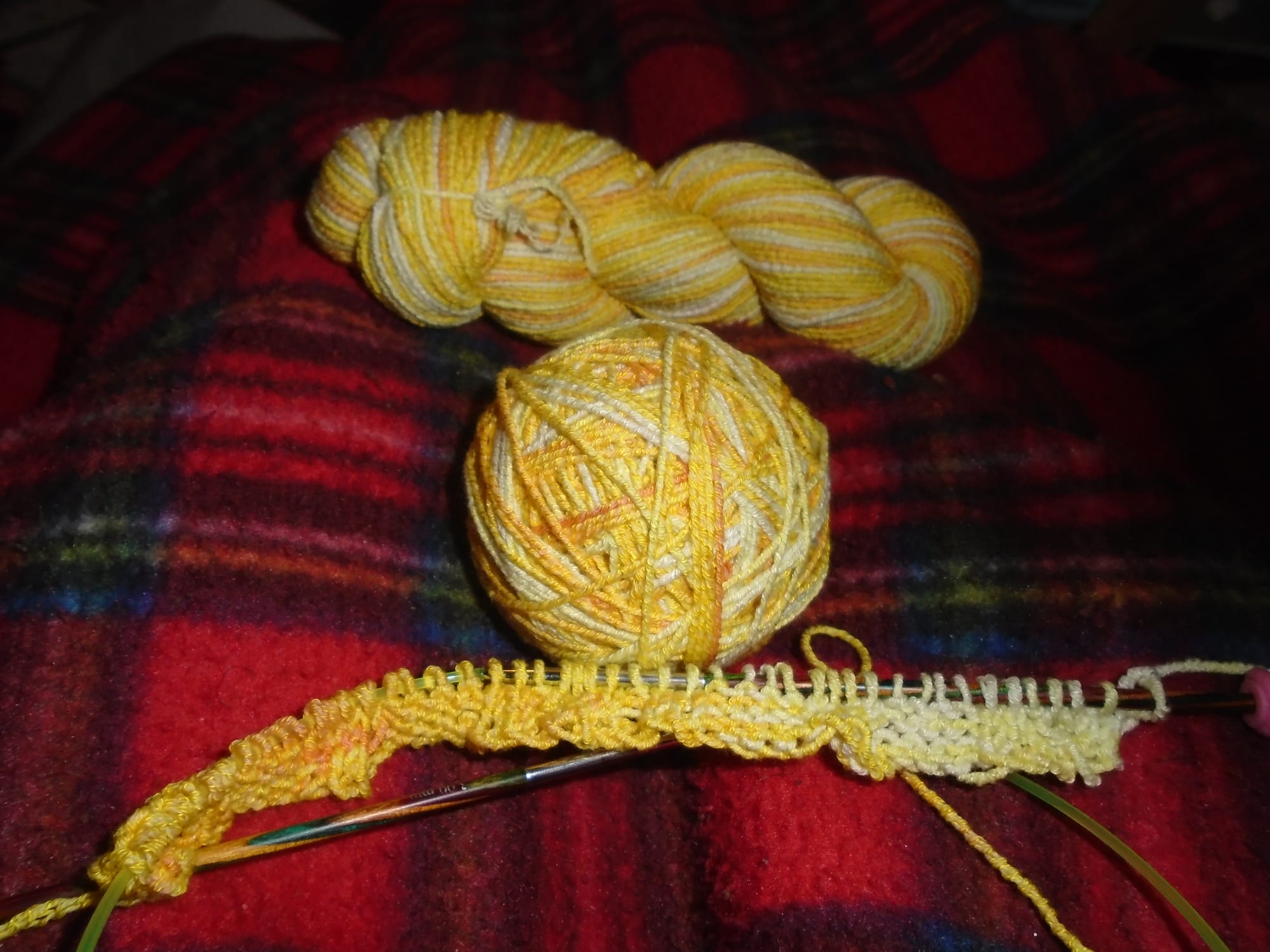
This photo shows the texture of the yarn pretty well. It is not soft and fluffy. It is kind of crepey. These socks are going to feel more like cotton than wool. I don't mind, though, just so long as they're warm.
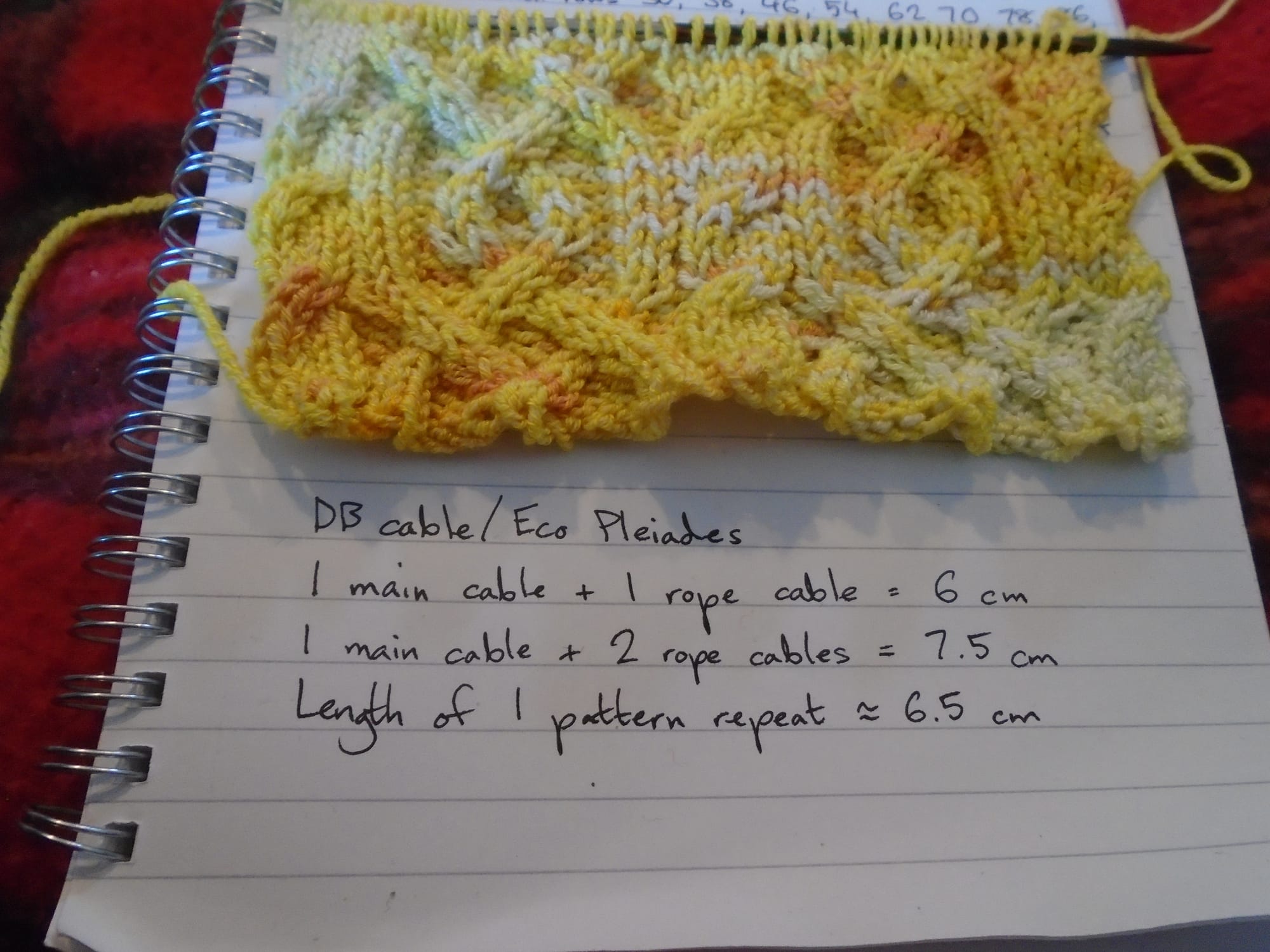
The first thing I did was to work a cable swatch. "DB" in the notes under the swatch stands for "Debbie Bliss" - it's the same cable design she uses in her edge-to-edge jacket pattern, and I like it a lot, so I decided to see how it would work for socks. "Eco Pleiades" is the name of the yarn.
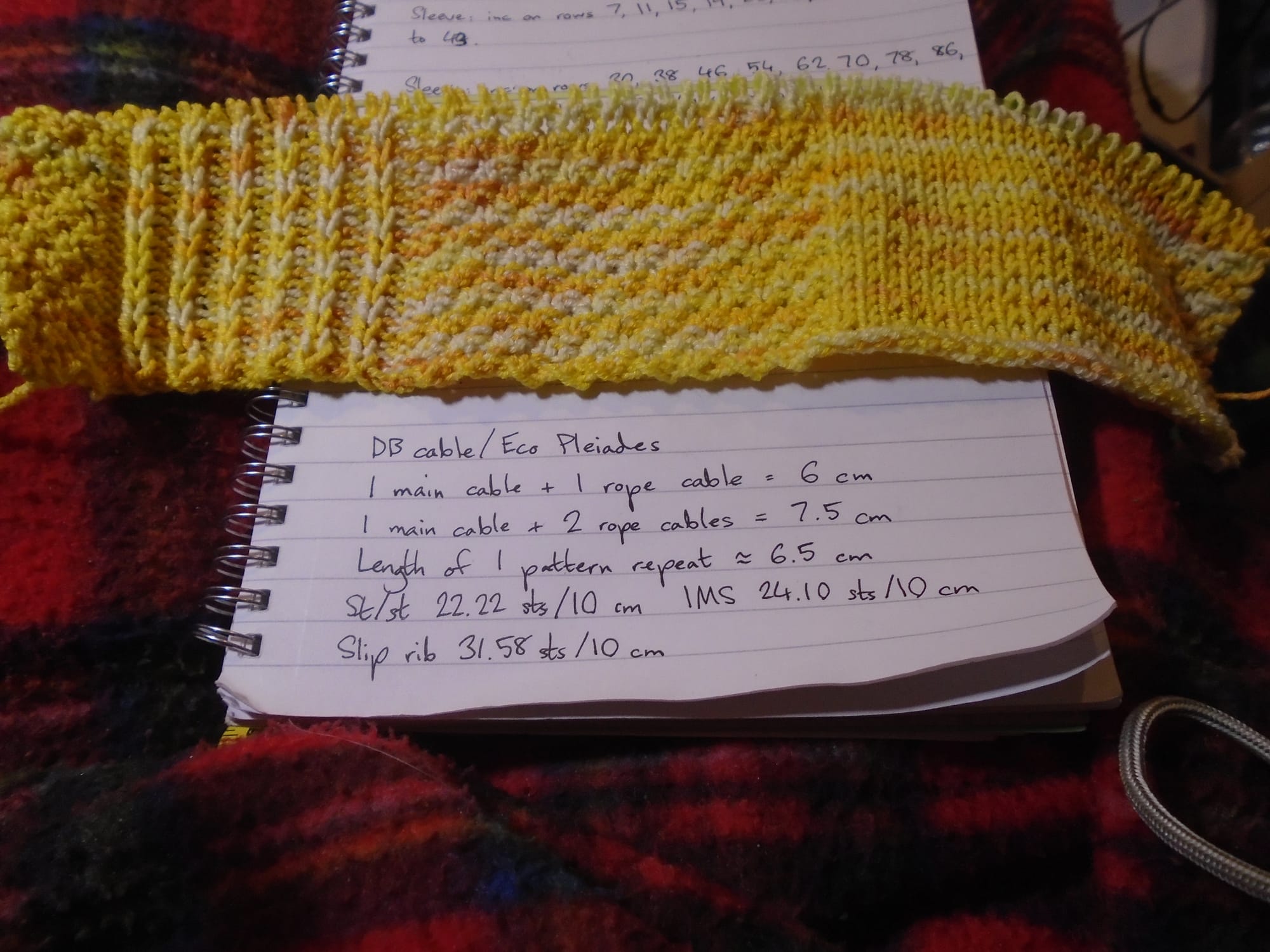
Then I unravelled the cable swatch and re-knitted to check the tension for various possible filler stitches: stocking stitch, Irish moss stitch, and 1 x 2 slip rib. That resulted in a few surprises. For a start, I was using a fingering-weight yarn on 3.0 mm needles, so I was expecting rather more than 22.22 stitches to 10 cm in stocking stitch (to give you a rough idea, Stylecraft Special DK gives a tension guide of 22 stitches to 10 cm on 4.0 mm needles). My tension is not generally loose. In fact, it's pretty much bog standard, so I have no idea what is going on here. The Irish moss stitch pulls in a little but not very much, which is about what I'd have expected, but I wasn't expecting quite so much pull-in with the slip rib. I know, it's a rib, but nonetheless you can still clearly see the two purl stitches between the slipped columns. It doesn't look obviously pulled in. Nonetheless, as you can see, the effect is quite significant; so if I ever get to knit a pair of socks for d'Artagnan (who, if you recall, stuffs his trousers down them while cycling), there'll be slip rib involved. Nice and stretchy, and capable of accommodating even his thick winter joggers.
So that is where we are at the moment, except I've now rewound the whole set of skeins for this pair of socks, so I have little balls of yarn and am all ready to go as soon as I have my foot template. I shall be designing as I go, so expect some fun and maybe a few mistakes.
Oh! And one more thing. Remember those crochet hooks I bought for the purpose of hooking the yarn over the lucet?
Yup. My previous notes have reminded me that one of the most effective ways to cast off a pair of socks is... double crochet. I do love it when everything just comes together like that!

